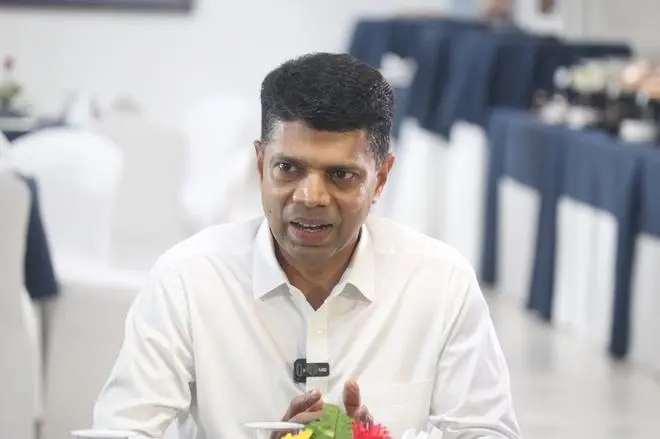
Students inside the computer lab in Puri Zila School
Earlier in November, the Ministry of Education released its annual UDISE+ report for the academic year 2021-22. The report captures annual data about schools, noting how they progress. Going by the numbers in the report, in that academic year, when the country was just recovering from the pandemic, just 8.1 per cent of the government schools in Odisha had access to an internet connection, placing the state among the lowest performers in the country. About 4.2 per cent of government-run schools had access to smart classrooms then.
While the data was out quite recently, the numbers tell a dated story. The State’s School and Mass Education Commissioner cum Secretary Aswathi S and former IAS officer VK Pandian, the Chairman of the State’s 5T are confident that the upcoming reports will have a different story to tell altogether. Through the 5T (Transparency, Technology, Teamwork, Time, Transformation) initiative launched in 2021, the Odisha government is gearing up to transform 8,679 of its government-run high schools, providing internet connections, equipping them with smart classrooms, libraries and labs, and improving the overall infrastructure. The targeted deadline for the initiative is the end of the ongoing academic year (2023-24), which ends in March 2024. “All the classes will be smart classrooms,” says an enthusiastic Pandian, who formally joined the ruling Biju Janata Dal earlier this year.

VK Pandian, Chairman, 5T
Pandian says that in a later stage, the State also plans to deploy AI as a tool to explain complex subjects to students. “We have already tied up with UC Berkley as our technology partner for this project in July,” he says. “This will be a game changer, which will be truly transformative. The best of teachers also, sometimes the way they explain may not be the best way for a student to adapt. That is a gap that we’re trying to bridge,” he says.
About a kilometre and a half from the iconic Puri Jagannath Temple is the 170-year-old Puri Zila School, one of the oldest government-run schools in Odisha. It boasts of alumni-like freedom fighter Gopabandhu Das and poet Kalindi Charan Panigrahi and currently, has a strength of 1,650 students. Given all this, it may not be a surprise to note that Puri Zila School was among the 1,075 schools that were picked to transform in the first stage of the programme.
Puri Zila School
Fresh coats of pistachio green paint adorn the walls of the double-storeyed school building. It’s quite evident that the floor tiles are quite new and trendy and almost all their classrooms have wooden panels with inbuilt cupboards, redefining one’s idea of a mainstream government school.
Puri Zila School’s Alumni Wall of Fame
Jyotirmayee Mishra, the school’s principal says, “Currently, we have eighteen smart classrooms, two science laboratories and 11 types of sports facilities. Our goal is to ensure that our students graduate from this school mastering something, be it academic or extra-curricular.” Mishra also notes that following the transformation, she made it a point to pull her son out of a private school and get him enrolled in Puri Zila School. Between 2021-22 and 2022-23, there was a 1.57 per cent increase in the enrolment rate in Odisha’s government schools.
A two-hour journey from Puri takes you to Kushabhadra High School in Odisha’s Khorda district. The school was inducted as part of this transformative programme in the second phase of 2021-22. Even though the school now boasts facilities like a dimly lit computer lab, a library, smart classrooms, and science laboratories for ninth and tenth graders, it would seem like it still has a long way to go to get fully transformed. Notably, the electricity connection was quite unstable, forcing students to perform science experiments in the dark.
The computer lab-cum-library at Kushabhadra High School
In the same school, while the high schoolers were taught in smart classrooms, primary and middle schoolers studied in classrooms without benches or desks, where they sat on a sheet laid on plain ground. When the contrast was pointed out, Pandian said, “We are planning on transforming primary classes in the next phase of the programme. In it, our primary focus will be infrastructure. That way, children will be encouraged to come to school.”
He added that primary school transformation has already begun in Hinjli, the constituency of Chief Minister Naveen Patnaik. Pandian, who seemed to have no doubts about Patnaik and BJD coming back to power in the state in 2024, also said, “In his next term, the Chief Minister has planned to expand the programme to primary and elementary schools in the state.”
(The writer visited Odisha recently on the Government of Odisha’s invite)
Published on December 29, 2023

Comments
Comments have to be in English, and in full sentences. They cannot be abusive or personal. Please abide by our community guidelines for posting your comments.
We have migrated to a new commenting platform. If you are already a registered user of TheHindu Businessline and logged in, you may continue to engage with our articles. If you do not have an account please register and login to post comments. Users can access their older comments by logging into their accounts on Vuukle.